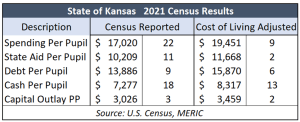Some things never change – spending increases, achievement remains low, and Kansas has one of the nation’s worst productivity rankings (bang for the education buck).
A dollar spent in Kansas buys a lot more than a dollar in New York or California, so we adjust spending and other amounts for comparison to  other states using the Missouri Economic Research and Information Center (MERIC) cost of living index.
other states using the Missouri Economic Research and Information Center (MERIC) cost of living index.
For the most recent available 2021 school year, Kansas had the 9th-highest spending per pupil, at $19,451; the national average was $17,119. Kansas has the 2nd-highest state aid at $11,668 per pupil.
Kansas also is ranked #6 for cost-of-living-adjusted debt per student, #13 for cash per student, and #2 for capital outlay per student.
Low ‘bang for the education buck’ in Kansas
Kansas has high national rankings on spending, but achievement on the 2022 National Assessment of Educational Progress – the gold standard of comparing states – is below the national average. Kansas’ composite score is 243 for the eight main measurements (4th-grade and 8th-grade reading and math for low-income students and everyone else), whereas the national average is 246.
We can measure each state’s relative productivity – what some might call ‘bang for the education buck’ – by dividing per-student spending adjusted for the cost of living by the NAEP composite score to find the cost per point scored.
With COL-adjusted spending at $19,451 per student, Kansas is spending $80 per NAEP point. That’s worse than the national average of $70 per point, placing Kansas at #42 on the ‘bang for the education buck’ ranking.

Once again, the data disproves the education lobby’s claim that spending more money is the key to achieving better outcomes. For example, 31 states have the same or better NAEP composite as Kansas but spend less per student.
Here’s another example. Ten states have a 247 NAEP composite, but spending goes from a low of $10,595 per student in Utah to $23,568 per student in New York.
The nation’s leading school choice states – Florida and Arizona – have great ‘bang for the education buck.’ Florida and Arizona spend almost $8,000 per student less than Kansas, but Florida has a better NAEP composite and Arizona is the same as Kansas.
The Kansas Association of School Boards claims the state’s public school system is #13 for achievement, but that’s never been true. Kansas’ NAEP proficiency rankings range #20 to #44, and ACT demographic scores are in the mid-30s. So how does KASB torture low outcomes to get a high ranking? By cooking the books!
Its methodology counts things that are not measures of academic preparation, like high school graduation and drop-out rates and post-secondary education enrollment, which collectively account for two-thirds of the points in the overall ranking. And some of the achievement outcomes they use count some students’ performance twice.
Unfortunately, the public education system will not take corrective action.
As we explained in Giving Kids a Fighting Chance with School Choice, the Kansas public education system – management, not teachers – prioritizes the institutional interests of the system over student needs. The book tells one story after another of education officials consciously deceiving parents and legislators, de-emphasizing academic improvement, and even ignoring state laws designed to improve achievement.
The only question is when the Legislature will have had enough of the excuses and of being targeted as the bad guys, and step in to give kids a fighting chance. This documentary tells how the Florida Legislature implemented a package of reforms (choice, transparency, and accountability) that propelled students from being among the worst achievers in the nation to some of the best.




